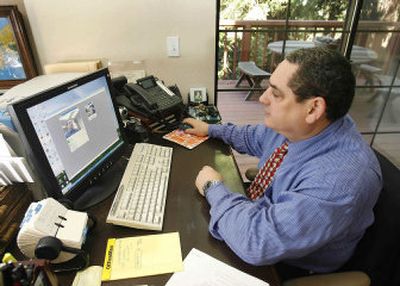‘Virtual visits’ let parents connect with far-off kids

SPRINGFIELD, Ill. – Divorce put David List and his 2-year-old daughter on opposite sides of the Atlantic Ocean, and he worried that she would soon forget him.
She hasn’t, though. List’s divorce agreement guaranteed him “virtual visitation” – the chance to talk with his daughter through an Internet video connection – and he and Ruby Rose, now 5, usually connect at least twice a week. The chats sustain them in between their in-person visits, which come only a few times a year.
“When she gets off the plane, I know what she had for dinner last night,” said List, 49, of Santa Cruz, Calif. “She’ll run right up to me and jump in my arms because I know exactly what she’s all about.”
Advocates of virtual visitation want states to spell out in their laws that judges can make it part of a divorce agreement.
The benefits go beyond helping parents and children stay close, supporters argue. They say noncustodial parents are more likely to pay child support regularly if they can stay in touch, and electronic visits can help keep children from getting caught up in fights when bickering exes meet in person.
Utah made virtual visitation an official option in 2004, and similar legislation awaits the governor’s signature in Wisconsin. Illinois, Missouri and Virginia lawmakers have introduced proposals, too.
“A telephone can only go so far,” said Republican state Rep. Ruth Munson of Illinois.
The idea has its critics, though, who fear judges might use the option of virtual visitation as justification for ordering fewer real visits with children or letting one parent move away with the children.
“Real parents need real time. Real kids need real time,” said David L. Levy, director of the Children’s Rights Council.
“It can be a wonderful accessory, but the danger is that it will be used as a substitute for real visitation.”
Virtual visitation agreements can cover things as mundane as telephone calls, e-mail and instant messages, but the focus is on video connections. With the technology becoming more commonplace and affordable, divorce lawyers say more parents are using it, often without any formal court agreement.
But many lawyers and judges are still unaware of it.
“I think that it is an evolution and, unfortunately, a lot of older attorneys aren’t even aware that it is an option,” said Cheryl Hepfer, president of the American Academy of Matrimonial Lawyers and a Rockville, Md., attorney.
Hepfer said she has seen cases where virtual visitation helped keep the peace between exes because seeing the child’s face eased the absent parent’s fear that the child was being manipulated or monitored. She also called it “common sense” that parents using virtual visitation would be more willing to pay child support.
While most judges already can authorize virtual visitation, they hesitate to order it because it’s not addressed in the laws, experts said. Lawyers can be reluctant to fight for it for the same reason.
“Lawyers have tried. It’s very hard,” said Jeffrey Leving, a divorce lawyer in Chicago who specializes in fathers’ rights cases.